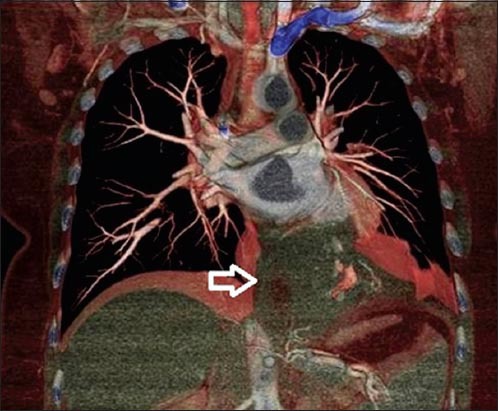Gastrointestinal (GI) stromal tumors (GISTs) are the most common mesenchymal tumors of the GI tract, but less than 2% of all GISTs are located at the esophagus. GISTs are classified as spindle cell, epithelioid, and pleomorphic mesenchymal tumors, usually express the KIT protein, and harbor mutation of a gene that encodes for a type III receptor tyrosine kinase. Debate exists regarding GIST nomenclature, diagnosis, and prognosis [1].
A 47-year-old female presented with progressively worsening dysphagia and epigastric tenderness dating since two years. A large hypodense elliptical mass occupying the left mid lung was identified initially on chest x-ray and computed tomography (CT) scan. The mass was contiguous with the esophagus, extending from the left atrium, through the hiatus to the pancreatic corpus and splenic vein (Fig. 1). Esophagogastroduodenoscopy showed no infiltration.
Figure 1.

Coronal view of computed tomographic reconstruction showing the tumor in the left hemithorax (arrow indicates the tumor)
Thoracotomy and enucleation of the tumor at the cardio-esophageal junction were performed. The anterior esophageal wall was resected, leaving the posterior wall intact. The resected mass macroscopically resembled a benign tumor.
Intraoperative biopsy was suspicious of stromal tumor, but final reports suggested a GIST (positive for CD34, CD117, vimentin; partially positive for desmin; negative for SMA, CK5/6, CK7; Ki67 index was 3-5%). Since discharge the patient remains free of symptoms.
GISTs originate from the interstitial cells of Cajal and are rare [2]. They typically present in adults 40-50 years old. GISTs of the GI tract are located: 60% in the stomach; 30% in the small intestine; and 10% in the esophagus, colon, and rectum [3]. Extraintestinal tumor locations are less frequent [4]. KIT or DOG 1 are expressed in the majority of GISTs and mutations in KIT or platelet-derived growth factor receptor-α (PDGFRA) polypeptide are very common [5]. Desmin and S-100 are rarely positive [5]. Existing literature shows that esophageal GISTs usually present with upper GI complaints (dysphagia, odynophagia, regurgitation, epigastric discomfort). The majority of published cases report tumors larger than 10 cm [6].
CT is the method of choice for primary evaluation and accurate staging of a suspected GIST. Magnetic resonance imaging has comparable diagnostic value, but may be preferred for rectum and liver GIST [7]. Positron emission tomography imaging detects smaller lesions and can dissolve diagnostic ambiguities. GI endoscopy findings may include a smooth protrusion of the wall, occasionally with signs of bleeding and ulceration. Either standard or endoscopic ultrasound-guided biopsies may not harvest enough tissue. A preoperative biopsy of a suspected resectable GIST is not recommended, but it is obligatory for metastatic disease.
The preferred method of treatment is surgical resection. If tumor size is less than 5 cm, lymph node resection is not necessary. Open surgery is indicated for large tumors, leaving laparoscopic resection for smaller tumors.
Molecular-targeted therapies, such as imatinib, may result in higher overall survival rates in high-risk patients, especially in unresectable and metastatic tumors [8]. PDGFRA mutation D842V, sporadic wild-type G, BRAF-mutated GIST, and mutations with succinate dehydrogenase rarely respond to imatinib. In patients with advanced disease in whom imatinib has failed, sunitinib is the best alternative choice [9].
Biography
Laiko General Hospital, National and Kapodistrian University of Athens, Medical School, Athens, Greece
Footnotes
Conflict of Interest: None
References
- 1.Suster S. Gastrointestinal stromal tumors. Sem Diag Pathol. 1996;13:297–313. [PubMed] [Google Scholar]
- 2.Burkill GJ, Badran M, Al-Muderis O, et al. Malignant gastrointestinal stromal tumor: distribution, imaging features, and pattern of metastatic spread. Radiology. 2003;226:527–532. doi: 10.1148/radiol.2262011880. [DOI] [PubMed] [Google Scholar]
- 3.Miettinen M, Sarlomo-Rikala M, Lasota J. Gastrointestinal stromal tumor: recent advances in understanding of their biology. Hum Pathol. 1999;30:1213–1220. doi: 10.1016/s0046-8177(99)90040-0. [DOI] [PubMed] [Google Scholar]
- 4.DeMatteo RP, Lewis JJ, Leung D, et al. Two hundred gastrointestinal stromal tumors: recurrence patterns and prognostic factors for survival. Ann Surg. 2000;231:51–58. doi: 10.1097/00000658-200001000-00008. [DOI] [PMC free article] [PubMed] [Google Scholar]
- 5.Bachet JB, Emile JF. Diagnostic criteria, specific mutations, and genetic predisposition in gastrointestinal stromal tumors. Appl Clin Genet. 2010;3:85–101. doi: 10.2147/TACG.S7191. [DOI] [PMC free article] [PubMed] [Google Scholar]
- 6.Blay JY, Bonvalot S, Casali P, et al. Consensus meeting for the management of gastrointestinal stromal tumors. Report of the GIST Consensus Conference of 20-21 March 2004, under the auspices of ESMO. Ann Oncol. 2005;16:566–578. doi: 10.1093/annonc/mdi127. [DOI] [PubMed] [Google Scholar]
- 7.Miettinen M, Sarlomo-Rikala M, Sobin LH, Lasota J. Esophageal stromal tumors: a clinicopathologic, immunohistochemical and molecular genetic study of 17 cases and comparison with esophageal leiomyomas and leiomyosarcomas. Am J Surg Pathol. 2000;24:211–222. doi: 10.1097/00000478-200002000-00007. [DOI] [PubMed] [Google Scholar]
- 8.Scarpa M, Bertin M, Ruffolo C, Polese L, D’Amico DF, Angriman I. A systematic review on the clinical diagnosis of gastrointestinal stromal tumors. J Surg Oncol. 2008;98:384–392. doi: 10.1002/jso.21120. [DOI] [PubMed] [Google Scholar]
- 9.Blay JY, Le Cesne A, Cassier PA, Ray-Coquard IL. Gastrointestinal stromal tumors (GIST): a rare entity, a tumor model for personalized therapy, and yet ten different molecular subtypes. Discov Med. 2012;13:357–367. [PubMed] [Google Scholar]


